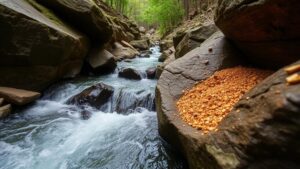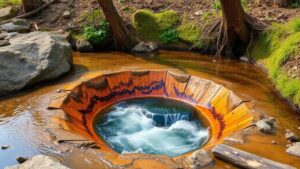Recovering Gold Nuggets From Narrow Bedrock Gorges Using Hand Tools
Recovering Gold Nuggets From Narrow Bedrock Gorges Using Hand Tools
The allure of gold has captivated humanity for centuries, and the pursuit of precious nuggets in narrow bedrock gorges is a testament to this fascination. This article aims to provide a comprehensive understanding of the techniques and tools employed in recovering gold nuggets from such challenging environments, alongside practical insights and industry knowledge.
Understanding the Geology of Gold Deposits
Gold is typically found in quartz veins or as alluvial deposits in riverbeds. Narrow bedrock gorges offer unique conditions for gold accumulation due to erosion and sediment deposition. geology of these areas often consists of hard rock formations where gold can become trapped.
Geologically, these gorges are formed by significant water flow, which scours the bedrock. Often, the intersections of ancient river systems serve as hotspots for gold deposition, leading to the formation of rich pockets known as pay streaks.
Essential Hand Tools for Gold Recovery
Effective recovery of gold nuggets from narrow gorges relies on a selection of efficient hand tools, including:
- Gold Pan: A shallow basin that allows for the separation of gold from other materials through a process called panning.
- Hand Sluice Box: A rectangular trough designed to catch nuggets and fine gold as water and material flow through it.
- Pick and Shovel: Essential for excavating dirt and gravel from crevices in the bedrock.
- Crevice Tool: A narrow, pointed tool that is ideal for extracting material from narrow cracks and crevices in bedrock.
Each of these tools plays a vital role in the recovery process, allowing prospectors to effectively manage the difficulties posed by the environment.
The Recovery Process
Recovering gold nuggets requires a systematic approach, typically following these steps:
1. Site Identification
Choosing the right location is crucial. Utilizing maps and local geological surveys can highlight areas with historical gold deposits. Field research may involve examining the terrain and identifying potential gorges.
2. Excavation
Once a promising site is located, excavation begins. Utilizing a shovel, the prospector removes debris and gravel from the gorge. Care should be taken not to disturb the bedrock more than necessary, which can lead to valuable material being lost.
3. Panning and Sluicing
The material collected is then processed using a gold pan or sluice box. In the pan, water is added and the material is agitated to separate heavier gold particles from lighter debris. The sluice box captures gold as water flows over it, utilizing riffles to slow down the flow and trap particles.
4. Crevice Extraction
Crevice tools are used to pry open tight spaces and extract dirt and gravel that may contain trapped gold. This step is labor-intensive but often yields significant results, as gold can easily become trapped in these tight spots due to its density.
Environmental Considerations
It is important to approach gold recovery responsibly, considering the potential environmental impacts. Practices such as:
- Avoiding excessive digging that can lead to habitat destruction.
- Restoring the site after mining to minimize lasting effects on the ecosystem.
These actions ensure that the delicate balance of the natural environment is maintained while allowing for sustainable gold recovery.
Case Studies and Real-World Applications
Practical examples of successful gold recovery can be found across various locations. For example, prospectors in Californias Sierra Nevada have utilized hand tools with remarkable success in narrow gorges, recovering the state’s historical nuggets dating back to the Gold Rush era. Similarly, the Klondike region in Canada has seen modern prospectors applying traditional methods, yielding substantial returns.
Statistics indicate that small-scale miners contribute significantly to local economies, with the U.S. Department of the Interior reporting that recreational mining generates $1.6 billion annually, highlighting the economic importance of these activities.
Actionable Takeaways
For those interested in gold recovery from narrow bedrock gorges, consider the following steps:
- Conduct thorough research on geology and previous gold finds.
- Equip yourself with essential hand tools tailored for the task.
- Practice responsible mining techniques, ensuring environmental consideration.
By following these guidelines, aspiring prospectors can enhance their chances of success while contributing positively to their communities and preserving the natural landscape.


